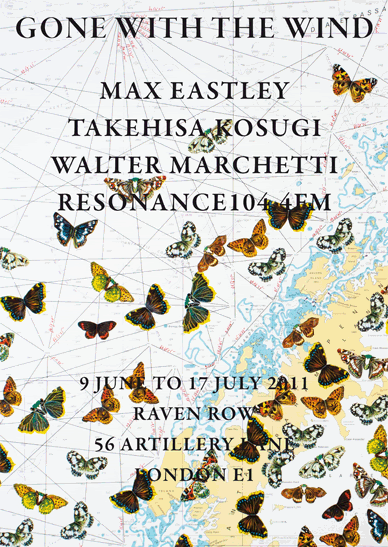The Thing is / The Thing
The current exhibition at Raven Row gallery, Gone With the Wind, is an exhibition about sound, governed by a pervasive silence. Featuring the work of Walter Marchetti, Max Eastley and Takehisa Kosugi, the show is less about sound as a medium or material form, and more an exploration of a landscape in which inconsistencies, subtleties, accidents and interjections become the agents of incidental sonic encounter.
Rather than clamouring with strains of the experimental music that is inherent to the practice of all three artists, the exhibition is buffeted by the quiet of exquisite watercoloured notebook pages (Eastley's), the heat pulse of a piano wrapped in Christmas lights (Marchetti's) and the compelling trail of documentary images of Japanese Fluxus gatherings (Kosugi's). The curator, Resonance FM's Ed Baxter speaks of "a willingness to wait patiently for sound to emerge ... or not" as characteristic of the work on show and indeed it does appear as a kind of landscape full of ghostly monuments and geographic features in waiting. We might imagine this landscape as characterised by the stave, the site of musical notation, which appears among the documentation of all three artists.
The approaches to this theoretical rigour are all equally riotous; populated with blocks of primary colour/rhythm (calling to mind synesthesic practice); maculate with manic black marks that over-roost the stave's like swarming birds, or else they are absent of notes, the stacked lines themselves subject to delicate recolouring and fracture as if to illustrate the concern with playing around space rather than within it - of listening intently to what is already available to hear; the base resonance's that will always, empirically form a foundation for created sound.
The overriding question or experiment seems to be, what happens to sound (or to a room) when objects are placed within it? How does their presence affect inherent or applied sound? This calls to mind Alvin Lucier's seminal 1969 recording "I am Sitting in a Room" in which Lucier endeavoured to s-s-s-smmmooth out his speech by immersing himself in the natural sonic frequencies of a particular space. The amalgamation of his physical presence and the electronic manipulation of the recording acting as a balm upon the aural blemishes in his words.
I'm interested in the possibility of this happening visually as well as sonically. While at the gallery I was lucky enough to see a performance by Esther Ferrer, the creator of some vital experimental works in the 1960's and a collaborator of Marchetti's. She presented her work Las Cosas (The Things) which seems to have been performed for the first time around 1988. Ferrer engages in a process of making pictures with her body. A selection of mundane objects are juxtaposed with her naked / part naked form to create bizarre statues while a recorded voice marks the passing time.
I'm often a little troubled by the presence of performance works as add-ons to exhibitions, rather than having space to themselves, but on reflection, the siting of her strange procession of statues within the quiet sonic landscape of the exhibition, fits well with the ethos of the curated works. Randomly, possibly and impossibly things can appear to change the dynamics of an encounter, whether this be a note on a stave or a body, sitting in a room.
The building sensations of discomfort, curiosity, hilarity or embarrassment felt within the crowd at the sight of the elderly artist, bare breasted and crowned with a portable TV or monkey toy, palpably changed the dynamics of the room in the same sense that Lucier's recorded feedback threw light on the sounds that we experience but are not tuned in to. As the recorded, metronomic voice ebbed on and the audience tuned in to the systematic rhythms of Ferrer's ritual, the space, and the experience of it, began to change. You are alerted to different things, things that are usually lost underfoot.
The title of the work refers perhaps not only to the surreal arsenal of objects in Ferrer's bags but also to these unnameable elements.
Resonance FM are broadcasting from the gallery throughout the exhibition and I like the idea of the rogue, taboo presence of dead air with which the exhibition is imbued, coming about at the behest of a radio station.
I think a station which programmes static, silence, wind and non sounds - like the beating of Eastley's butterfly wings - is my kind of station.
Exhibition runs until 17th July.




Comments